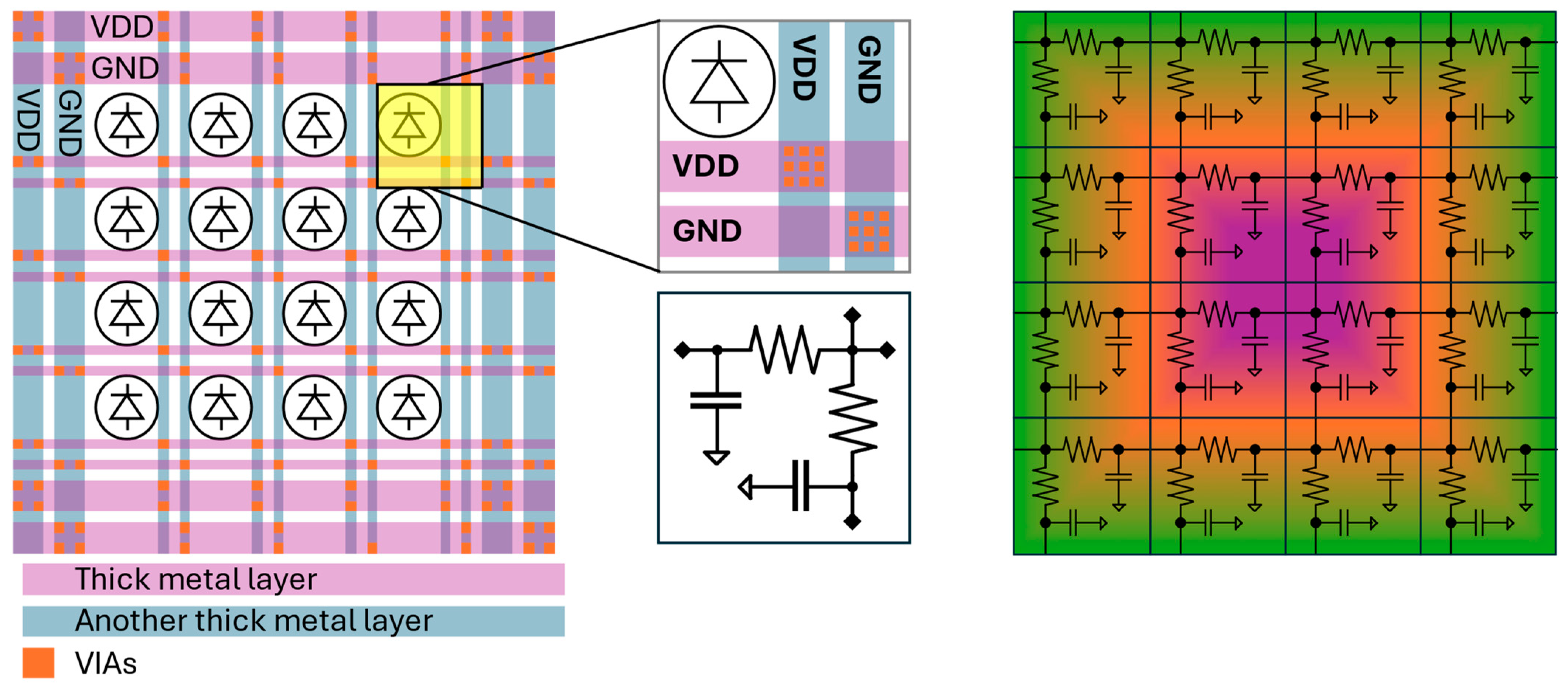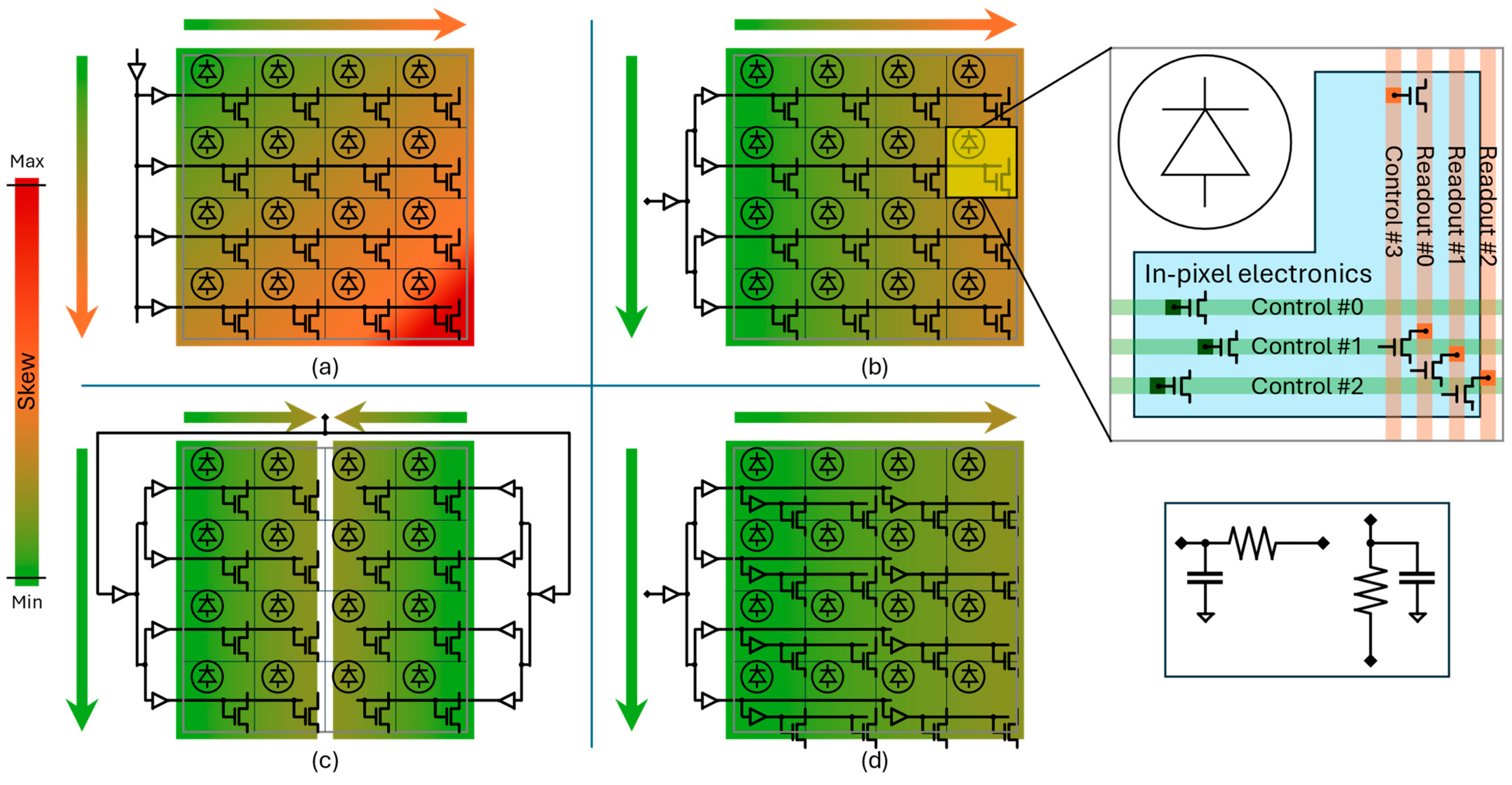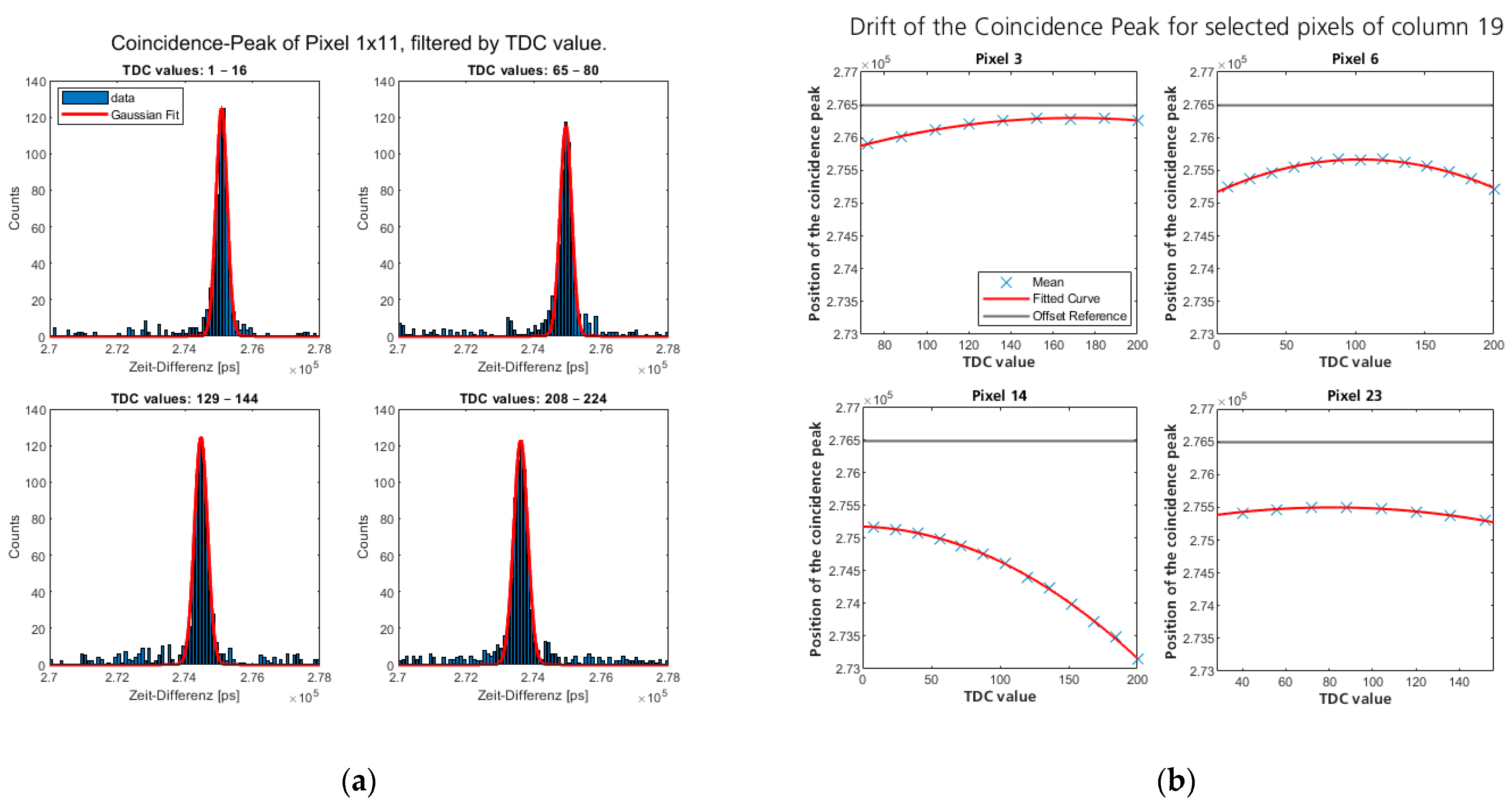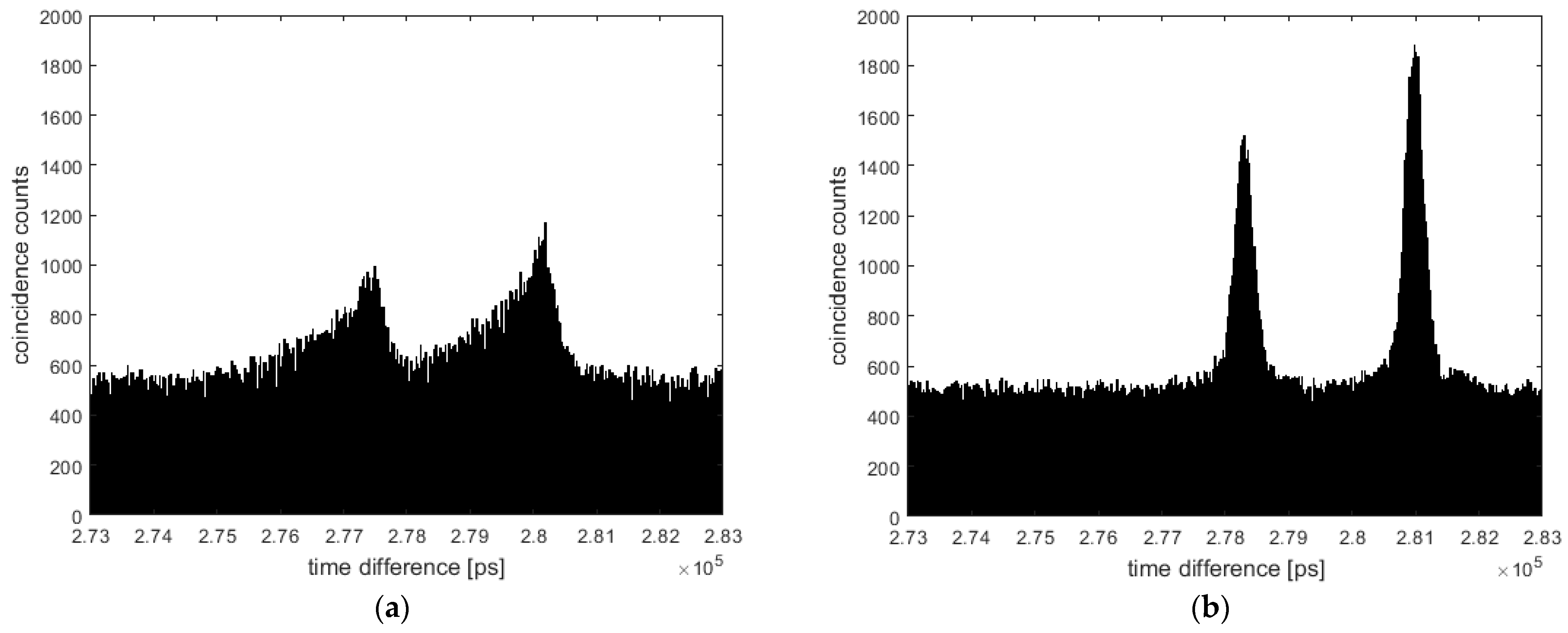A Method to Correct the Temporal Drift of Single-Photon Detectors Based on Asynchronous Quantum Ghost Imaging
Abstract
:1. Introduction
2. Sources of Temporal Drift
3. Correction Approach
3.1. Measurement System
3.2. Drift Determination
4. Results
5. Outlook
Author Contributions
Funding
Informed Consent Statement
Data Availability Statement
Conflicts of Interest
References
- Gyongy, I.; Dutton, N.A.W.; Henderson, R.K. Direct Time-of-Flight Single-Photon Imaging. IEEE Trans. Electron. Devices 2022, 69, 2794–2805. [Google Scholar] [CrossRef]
- Jahromi, S.; Jansson, J.-P.; Keranen, P.; Kostamovaara, J. A 32 × 128 SPAD-257 TDC Receiver IC for Pulsed TOF Solid-State 3-D Imaging. IEEE J. Solid-State Circuits 2020, 55, 1960–1970. [Google Scholar] [CrossRef]
- Niclass, C.; Rochas, A.; Besse, P.-A.; Charbon, E. Design and characterization of a CMOS 3-D image sensor based on single photon avalanche diodes. IEEE J. Solid-State Circuits 2005, 40, 1847–1854. [Google Scholar] [CrossRef]
- Sesta, V.; Pasquinelli, K.; Federico, R.; Zappa, F.; Villa, F. Range-Finding SPAD Array With Smart Laser-Spot Tracking and TDC Sharing for Background Suppression. IEEE Open J. Solid-State Circuits Soc. 2022, 2, 26–37. [Google Scholar] [CrossRef]
- Lindner, S.; Zhang, C.; Antolovic, I.M.; Wolf, M.; Charbon, E. A 252 × 144 SPAD Pixel Flash Lidar with 1728 Dual-Clock 48.8 PS TDCs, Integrated Histogramming and 14.9-to-1 Compression in 180NM CMOS Technology. In Proceedings of the 2018 IEEE Symposium on VLSI Circuits, Honolulu, HI, USA, 18–22 June 2018. [Google Scholar]
- Bronzi, D.; Villa, F.; Tisa, S.; Tosi, A.; Zappa, F. SPAD Figures of Merit for Photon-Counting, Photon-Timing, and Imaging Applications: A Review. IEEE Sens. J. 2016, 16, 3–12. [Google Scholar] [CrossRef]
- Erdogan, A.T.; Walker, R.; Finlayson, N.; Krstajic, N.; Williams, G.; Girkin, J.; Henderson, R. A CMOS SPAD Line Sensor with Per-Pixel Histogramming TDC for Time-Resolved Multispectral Imaging. IEEE J. Solid-State Circuits 2019, 54, 1705–1719. [Google Scholar] [CrossRef]
- Gersbach, M.; Trimananda, R.; Maruyama, Y.; Fishburn, M.; Stoppa, D.; Richardson, J.; Walker, R.; Henderson, R.K.; Charbon, E. High frame-rate TCSPC-FLIM using a novel SPAD-based image sensor. In Detectors and Imaging Devices: Infrared, Focal Plane, Single Photon; SPIE: Bellingham, WA, USA, 2010. [Google Scholar]
- Lin, Y.; Mos, P.; Ardelean, A.; Bruschini, C.; Charbon, E. Coupling a Recurrent Neural Network to SPAD TCSPC Systems for Real-time Fluorescence Lifetime Imaging. Sci. Rep. 2024, 14, 3286. [Google Scholar] [CrossRef] [PubMed]
- Suhling, K.; Hirvonen, L.M.; Levitt, J.A.; Chung, P.-H.; Tregidgo, C.; Le Marois, A.; Rusakov, D.A.; Zheng, K.; Ameer-Beg, S.; Poland, S.; et al. Fluorescence lifetime imaging (FLIM): Basic concepts and some recent developments. Med. Photon. 2015, 27, 3–40. [Google Scholar] [CrossRef]
- Kufcsák, A.; Erdogan, A.; Walker, R.; Ehrlich, K.; Tanner, M.; Megia-Fernandez, A.; Scholefield, E.; Emanuel, P.; Dhaliwal, K.; Bradley, M.; et al. Time-resolved spectroscopy at 19,000 lines per second using a CMOS SPAD line array enables advanced biophotonics applications. Opt. Express 2017, 25, 11103. [Google Scholar] [CrossRef]
- Hirvonen, L.M.; Suhling, K. Wide-field TCSPC: Methods and applications. Meas. Sci. Technol. 2016, 28, 012003. [Google Scholar] [CrossRef]
- Bruschini, C.; Homulle, H.; Antolovic, I.M.; Burri, S.; Charbon, E. Single-photon avalanche diode imagers in biophotonics: Review and outlook. Light. Sci. Appl. 2019, 8, 87. [Google Scholar] [CrossRef] [PubMed]
- Usai, A.; Finlayson, N.; Gregory, C.D.; Campbell, C.; Henderson, R.K. Separating fluorescence from Raman spectra using a CMOS SPAD TCSPC line sensor for biomedical applications. In Proceedings of the Optical Biopsy XVII: Toward Real-Time Spectroscopic Imaging and Diagnosis, San Francisco, CA, USA, 5–6 February 2019. [Google Scholar]
- Meier, K.; Ryan, D.; Thompson, D.; Newell, R.; Sandoval, R.; Werner, J.H. Quantum ghost imaging for non-destructive plant imaging using highly non-degenerate spontaneous parametric downconversion. In Proceedings of the Quantum Sensing, Imaging, and Precision Metrology, San Francisco, CA, USA, 28 January–2 February 2023. [Google Scholar]
- Pitsch, C.; Walter, D.; Gasparini, L.; Bürsing, H.; Eichhorn, M. 3D quantum ghost imaging. Appl. Opt. 2023, 62, 6275. [Google Scholar] [CrossRef] [PubMed]
- Markovic, B.; Tamborini, D.; Villa, F.; Tisa, S.; Tosi, A.; Zappa, F. 10 ps resolution, 160 ns full scale range and less than 1.5% differential non-linearity time-to-digital converter module for high performance timing measurements. Rev. Sci. Instrum. 2012, 83, 074703. [Google Scholar] [CrossRef] [PubMed]
- Nolet, F.; Dubois, F.; Roy, N.; Parent, S.; Lemaire, W.; Massie-Godon, A.; Charlebois, S.A.; Fontaine, R.; Pratte, J.-F. Digital SiPM channel integrated in CMOS 65 nm with 17.5 ps FWHM single photon timing resolution. Nucl. Instrum. Methods Phys. Res. Sect. A Accel. Spectrometers Detect. Assoc. Equip. 2018, 912, 29–32. [Google Scholar] [CrossRef]
- Henzler, S. Time-To-Digital Converters, 1st ed.; Springer: Dordrecht, The Netherlands, 2010. [Google Scholar]
- Tancock, S.; Arabul, E.; Dahnoun, N. A Review of New Time-to-Digital Conversion Techniques. IEEE Trans. Instrum. Meas. 2019, 68, 3406–3417. [Google Scholar] [CrossRef]
- Nemallapudi, M.; Gundacker, S.; Lecoq, P.; Auffray, E. Single photon time resolution of state of the art SiPMs. J. Instrum. 2016, 11, P10016. [Google Scholar] [CrossRef]
- Henderson, R.K.; Johnston, N.; Della Rocca, F.M.; Chen, H.; Li, D.D.-U.; Hungerford, G.; Hirsch, R.; Mcloskey, D.; Yip, P.; Birch, D.J.S. A 192 × 128 Time Correlated SPAD Image Sensor in 40-nm CMOS Technology. IEEE J. Solid-State Circuits 2019, 54, 1907–1916. [Google Scholar] [CrossRef]
- Nolet, F.; Lemaire, W.; Dubois, F.; Roy, N.; Carrier, S.; Samson, A.; Charlebois, S.A.; Fontaine, R.; Pratte, J.-F. A 256 Pixelated SPAD readout ASIC with in-Pixel TDC and embedded digital signal processing for uniformity and skew correction. Nucl. Instrum. Methods Phys. Res. Sect. A Accel. Spectrometers Detect. Assoc. Equip. 2019, 949, 162891. [Google Scholar] [CrossRef]
- Pelka, R.; Kalisz, J.; Szplet, R. Nonlinearity correction of the integrated time-to-digital converter with direct coding. IEEE Trans. Instrum. Meas. 1997, 46, 449–453. [Google Scholar] [CrossRef]
- Zarghami, M.; Gasparini, L.; Parmesan, L.; Moreno-Garcia, M.; Stefanov, A.; Bessire, B.; Unternahrer, M.; Perenzoni, M. A 32 × 32-Pixel CMOS Imager for Quantum Optics with Per-SPAD TDC, 19.48% Fill-Factor in a 44.64 μm Pitch Reaching 1 MHz Observation Rate. IEEE J. Solid-State Circuits 2020, 55, 2819–2830. [Google Scholar] [CrossRef]
- Pitsch, C.; Walter, D.; Grosse, S. Supplementary document for Quantum ghost imaging using asynchronous detection. Appl. Opt. 2021, 60, F66–F70. [Google Scholar] [CrossRef]
- Xu, H.; Pancheri, L.; Betta, G.-F.D.; Stoppa, D. Design and characterization of a p+/n-well SPAD array in 150 nm CMOS process. Opt. Express 2017, 25, 12765. [Google Scholar] [CrossRef]
- Stoppa, D.; Borghetti, F.; Richardson, J.; Walker, R.; Grant, L.; Henderson, R.K.; Gersbach, M.; Charbon, E. A 32 × 32-pixel array with in-pixel photon counting and arrival time measurement in the analog domain. In Proceedings of the 2009 Proceedings of ESSCIRC, Athens, Greece, 14–18 September 2009. [Google Scholar]
- Chen, H.; Li, D.D.-U. Multichannel, Low Nonlinearity Time-to-Digital Converters Based on 20 and 28 nm FPGAs. IEEE Trans. Ind. Electron. 2018, 66, 3265–3274. [Google Scholar] [CrossRef]
- Raisanen-Ruotsalainen, E.; Rahkonen, T.; Kostamovaara, J. An integrated time-to-digital converter with 30-ps single-shot precision. IEEE J. Solid-State Circuits 2000, 35, 1507–1510. [Google Scholar] [CrossRef]
- Villa, F.; Lussana, R.; Bronzi, D.; Tisa, S.; Tosi, A.; Zappa, F.; Mora, A.D.; Contini, D.; Durini, D.; Weyers, S.; et al. CMOS Imager with 1024 SPADs and TDCs for Single-Photon Timing and 3-D Time-of-Flight. IEEE J. Sel. Top. Quantum Electron. 2014, 20, 364–373. [Google Scholar] [CrossRef]
- Roy, N.; Nolet, F.; Dubois, F.; Mercier, M.-O.; Fontaine, R.; Pratte, J.-F. Low Power and Small Area, 6.9 ps RMS Time-to-Digital Converter for 3-D Digital SiPM. IEEE Trans. Radiat. Plasma Med. Sci. 2017, 1, 486–494. [Google Scholar] [CrossRef]
- Richardson, J.; Walker, R.; Grant, L.; Stoppa, D.; Borghetti, F.; Charbon, E.; Gersbach, M.; Henderson, R.K. A 32 × 32 50 ps resolution 10 bit time to digital converter array in 130 nm CMOS for time correlated imaging. In Proceedings of the 2009 IEEE Custom Integrated Circuits Conference, San Jose, CA, USA, 13–16 September 2009. [Google Scholar]
- Gasparini, L.; Garcia, M.M.; Zarghami, M.; Stefanov, A.; Eckmann, B.; Perenzoni, M. A reconfigurable 224 × 272-pixel single-photon image sensor for photon timestamping, counting and binary imaging at 30.0 µm pitch in 110 nm CIS technology. In Proceedings of the ESSCIRC 2022—IEEE 48th European Solid State Circuits Conference (ESSCIRC), Milan, Italy, 19–22 September 2022. [Google Scholar]
- Kuzucu, O.; Wong, F.N.C.; Kurimura, S.; Tovstonog, S. Joint Temporal Density Measurements for Two-Photon State Characterization. Phys. Rev. Lett. 2008, 101, 153602. [Google Scholar] [CrossRef] [PubMed]
- Morris, P.A.; Aspden, R.S.; Bell, J.E.C.; Boyd, R.W.; Padgett, M.J. Imaging with a small number of photons. Nat. Commun. 2015, 6, 5913. [Google Scholar] [CrossRef] [PubMed]
- IDQuantique. ID230 Product Page. Available online: https://www.idquantique.com/quantum-sensing/products/id230/ (accessed on 26 February 2024).
- PicoQuant. TimeHarp260 Product Website. Available online: https://www.picoquant.com/products/category/tcspc-and-time-tagging-modules/timeharp-260-tcspc-and-mcs-board-with-pcie-interface (accessed on 26 February 2024).







Disclaimer/Publisher’s Note: The statements, opinions and data contained in all publications are solely those of the individual author(s) and contributor(s) and not of MDPI and/or the editor(s). MDPI and/or the editor(s) disclaim responsibility for any injury to people or property resulting from any ideas, methods, instructions or products referred to in the content. |
© 2024 by the authors. Licensee MDPI, Basel, Switzerland. This article is an open access article distributed under the terms and conditions of the Creative Commons Attribution (CC BY) license (https://creativecommons.org/licenses/by/4.0/).
Share and Cite
Pitsch, C.; Walter, D.; Gasparini, L.; Bürsing, H.; Eichhorn, M. A Method to Correct the Temporal Drift of Single-Photon Detectors Based on Asynchronous Quantum Ghost Imaging. Sensors 2024, 24, 2578. https://doi.org/10.3390/s24082578
Pitsch C, Walter D, Gasparini L, Bürsing H, Eichhorn M. A Method to Correct the Temporal Drift of Single-Photon Detectors Based on Asynchronous Quantum Ghost Imaging. Sensors. 2024; 24(8):2578. https://doi.org/10.3390/s24082578
Chicago/Turabian StylePitsch, Carsten, Dominik Walter, Leonardo Gasparini, Helge Bürsing, and Marc Eichhorn. 2024. "A Method to Correct the Temporal Drift of Single-Photon Detectors Based on Asynchronous Quantum Ghost Imaging" Sensors 24, no. 8: 2578. https://doi.org/10.3390/s24082578




